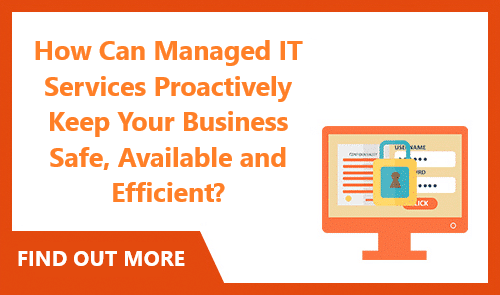Is My Business Too Small For Managed IT Support?
Small business owners and IT managers often juggle competing demands. You want to improve efficiency and productivity, but at what point do those improvements become too costly or difficult to sustain?
Let’s face it, most businesses can use technology to gain efficiencies. But, that doesn’t mean that the cost-benefit analysis works out for everyone.
In my 35 years in IT, I’ve worked with hundreds of small businesses like yours. I know the unique challenges small businesses face. In this article, I’ll provide all of the information you need to decide whether managed IT support is the right solution for your business.
In the interest of full disclosure, it’s important that you know that I work for Kelser, a managed IT company. It’s also important that you understand that I’m not here to sell you anything.
You see, at Kelser, we know that managed IT isn’t right for everyone. As much as we’d love to work with everyone, we know there are companies for which we are not the right fit.
Rather than tell you how great we are (which we are, by the way), we think it’s more important to provide you with unbiased information you can use to make the right IT decision for your organization. Why waste time working with the wrong IT company? It’s not good for you. It’s not good for us.
Instead, here’s some candid information about small businesses and managed IT. By the time you finish this article you’ll know what managed IT is, what it includes, what it doesn’t include, how much it costs, and the benefits and disadvantages for small businesses.
What Is Managed IT?
Managed IT is a subscription-based IT service. It offers a proactive approach. Rather than waiting for something to break and then contacting an IT firm to come in and repair it under the break/fix model, managed IT is an ongoing partnership in which an external provider manages part or all of your IT environment.
Both break/fix and managed IT have their place.
What Does Managed IT Include?
Managed IT includes a host of offerings that may differ depending on the provider, including:
-
Technology Experts & Strategic Planning
Not every IT provider offers the services of technology experts as part of their service package, but some offer a virtual chief information officer (vCIO), technical alignment manager (TAM), technical solutions architect and service delivery manager (SDM).
These advisors assist with technical, strategic, project management, and budget planning.
-
Service (Help) Desk
Most managed IT providers will include service desk assistance in the monthly agreement. Some providers may handle service internally, some may outsource it. Some will provide unlimited service calls, while others may limit the number of calls on a monthly or quarterly basis.
-
Managed Servers & Networks
With managed IT, servers and networks are proactively patched and updated, keeping them working efficiently and free from bottlenecks, congestion, performance issues, and failures.
-
Disaster Recovery
Proper data back-up and verification by a managed IT provider means data can be restored quickly in the event of a cyber incident or data breach.
-
Managed Workstations With Automated Patching
Managed IT providers keep workstations secure, up-to-date, and working efficiently with automated patching. Updates are applied without downtime, ensuring that security vulnerabilities are identified and closed.
Device health is monitored, and plans are made ahead for upgrades, replacements, and asset disposition.
-
Automated Monitoring
With managed IT, automated tools and systems continuously monitor the customer’s IT environment, notifying the provider of unusual activity. As a result, the provider can quickly resolve any issues.
-
Email Support
Managed IT typically includes the management of email and support for related technical issues that may arise.
-
Managed DNS-Based Protection
With DNS-based (Domain Name Service) protection, managed IT providers ensure that web addresses you think you are going to are safe and have not been compromised before you get there. It protects against phishing attacks and can keep mobile users safe on and off your local network.
-
Managed Spam Filtering And Protection
Managed IT usually includes anti-spam filters that check emails against industry-standard and organization-defined criteria for spam and virus controls.
When inbound or outbound items fail these checks, they are quarantined and not delivered, reducing dangerous and unnecessary email and preventing the distribution of malware, spam, and viruses.
-
Automated Maintenance
Scheduled maintenance happens automatically, behind the scenes to keep systems up-to-date while minimizing downtime.
-
License Management
Some providers also manage all of your licenses, freeing you up to manage your business.
-
Managed Anti-Malware
Managed IT providers use anti-malware to identify and stop attacks standard antivirus software doesn’t.
Anti-malware defends before, contains during, and helps remediate after an incident, constantly tracking programs, so you know exactly what’s running where and when across your endpoints. And, if a program suddenly becomes malicious, it alerts the IT provider.
-
Managed Employee Awareness Training
With managed employee awareness training, employees learn how to identify and respond to common threats, how to protect company information, and understand their role in the security of the business.
What Does Managed IT Not Include?
Managed IT does not typically include any special projects or network architecture upgrades that may be necessary.
In the same way that people can be surprised by the results of a physical at the doctor’s office, a network inspection can sometimes yield issues that nobody suspected.
Just because we feel fine doesn’t mean there isn’t an underlying issue that will be confirmed by bloodwork or other diagnostic tests. The same can be true of an IT infrastructure. It may be operating fine, but there could still be issues that need to be addressed (ideally, before they impact your users and customers).
How Much Does Managed IT Cost?
Managed IT providers charge a monthly fee of between $100 to $200 per employee device/computer user. For companies with 10 employees (who all use computers to do their work) the monthly managed IT fee would likely be between $1,000 to $2,000 per month for the organization.
As mentioned above there also may be one-time fees for projects and network architecture upgrades that fall outside the scope of regular managed IT fees.
What Are The Benefits Of Managed IT For Small Companies?
While we’ve mentioned that managed IT may not be right for everyone, some of the advantages that our small businesses customers mention are:
-
Predictable Monthly Cost
In the same way that people often find comfort in leasing a car, the same is often said of managed IT.
Rather than wonder what part or your infrastructure will fail next and how much it will cost (in both repair expense and down time), many small business owners take solace in knowing that they will pay the same rate each month.
The predictable monthly cost helps business owners sleep well and makes budgeting easier and more reliable.
-
Second Set Of Eyes
Another advantage that many small business owners mention is the assurance of a second set of eyes looking at their “stuff.” In the same way that other business functions have a set of checks and balances in place, a managed IT can provide the same service for your IT infrastructure.
-
Full Complement Of IT Experts
Whether the managed provider works in collaboration with your IT person or staff or handles all of your IT needs, they have all of the experts on staff to provide all of the care and feeding that your IT requires.
Let’s face it, whether you own a small business or a large business, your IT needs all of the same things, just on a different scale.
What Are The Disadvantages Of Managed IT For Small Companies?
We’ll be honest. There are some disadvantages to managed IT. Here are a couple of them:
-
Cost
While the costs we outlined above ($100-200 per user per month) may seem like a lot, many small businesses find that when they factor in the unpredictability and total expense (in both dollars and lost time) of other IT solutions, licensing fees, and the expense of fielding an IT staff in-house, the cost is comparable.
-
Staffing
You may already have an IT staff and be wondering how this will impact them. Most managed IT providers can work with your internal staff to provide your organization with the best of both worlds: an IT person on-site and the deep bench of expertise offered by a managed IT provider.
Is Managed IT Right For My Business?
The million-dollar question remains: what is right for your business? As I said at the outset, only you can decide whether managed IT is right for your business or not.
After reading this article, though, you have the information you need to make an informed decision. You know what managed IT is, what it includes and does not include, how much it costs, and the advantages and disadvantages for small businesses.
If you are considering managed IT, we recommend that you explore several providers. As part of that process, we invite you to learn more about Kelser’s Managed IT Support. Click the button below.




